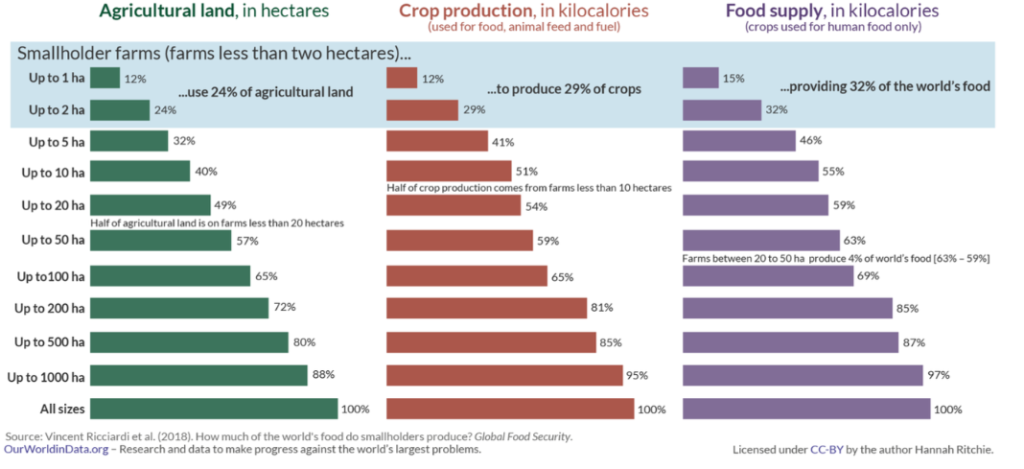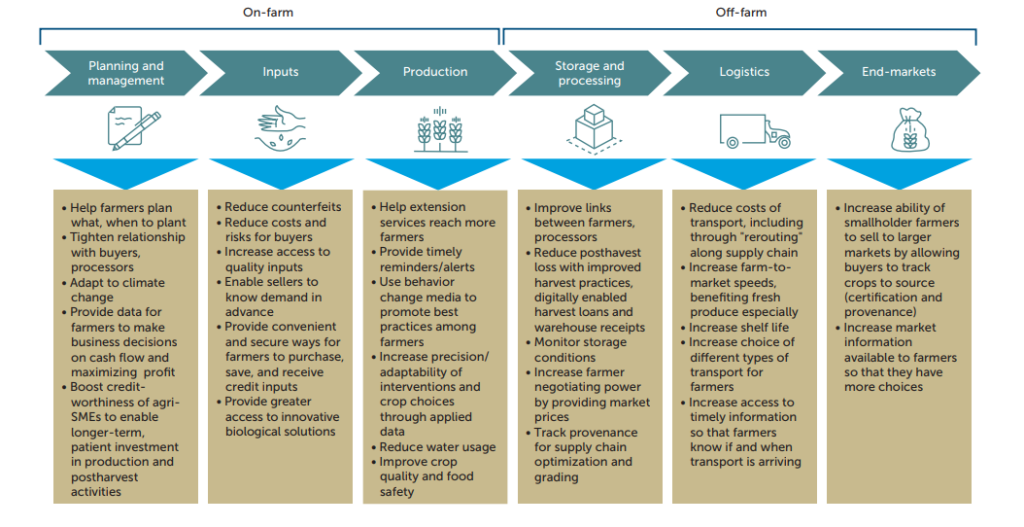Introduction
The world's food system is in disarray. The COVID-19 epidemic, Russia's invasion of Ukraine, and climate change have all contributed to supply disruptions and price increases. In addition, covering the food needs of 9.7 billion people by 2050, while reducing agriculture's environmental imprint at the same time, will be one of our most difficult long-term challenges. In this scenario, smallholders who are already big food supply chain contributors, are becoming even more essential (Fig.1).
Despite that, smallholders are facing a lot of old and new difficulties, including limited market access, land insecurity, and climate change. However, opportunities to enter supply chains and contribute to food security, poverty alleviation, and economic growth are rising for them. The following summary based on the handbook “Working with Smallholders” by the IFC explores the challenges that smallholder farmers face, while also addressing the opportunities and giving guidance on steps that should be followed to boost smallholders' presence in the world's agriculture scenario.

Multistakeholder partnerships strategies
To address shared, complex, system-level concerns that are beyond the scope or control of any single entity, multistakeholder partnerships (MSPs) are becoming a more prevalent strategy. The number of MSPs more than doubled between 2000 and 2015, according to the Global Development Incubator, with a focus on solving the following issues:
- Smallholder capacity development
- Climate and biodiversity issues
- Labor standards and supply chain equity
One of the possible ways to increase the chance of creating successful multistakeholder partnerships is through roundtable projects. Roundtable projects bring together stakeholders around a voluntary sustainability standards system and are typically centered on specific products. According to the IFC's handbook, this system increases uptake and opens chances for efficiency.
Overall, for a multistakeholder partnership to become successful, the following steps should be taken:
- The partnership should deliver value and address key challenges in the company's supply chain, furthermore, it should align with objectives, geographic focus, and competitive advantage.
- Establishing a mechanism of work, and considering and mitigating any risks. For example, companies should make sure that sufficient internal capacity is present.
- Defining a vision and sharing it with the partners.
- Measuring progress regularly and holding partners accountable for non-participation.
Firm-Level Incentives for Investing in Smallholders
According to the handbook by the IFC, it would be beneficial if agribusiness would collaborate more with smallholder farmers. For instance, the following incentives should appeal to agribusiness:
- Access to land (via smallholder's farms)
- Lower costs of labor supervision, lower fixed costs, and access subsidies
- Intensive local knowledge about growing conditions and more differentiated products
- Greater resilience
Yield gaps
The primary reason that food supply increased faster than demand over the last 50 years was an increase in yield. However, poorer countries and smallholder farmers still face a lot of obstacles and have the largest potential yield improvement. It is important to keep this in mind considering that yield improvements will remain critical to feeding the world's rising population sustainably. The following steps should increase the chances of successfully boosting yield, especially for smallholder farmers:
- Setting appropriate yield baseline, by comparing observed yields in close provinces, and from that setting suitable yield targets.
- Identifying key yield impact factors and determining the improvement pathway.
The full IFC report offers an overview of what factors can affect yield, read it here.
Agricultural technology for smallholders
The availability of digital solutions can reinforce smallholder supply chains. Emerging solutions can improve aspects like enhanced productivity and reduced bottlenecks, access to financial support, stronger links to quality input, and better nutritional outcomes.
Furthermore, according to the IFC's handbook, tech solutions also offer advantages to large-scale input providers working with smallholder farmers (SHFs): improved market links, less volatile supply volumes, more efficient use of energy and resources, and most importantly, improved safety and brand integrity.

In general, when designing and thinking about a digital solution to improve smallholders' performance, these steps should be considered:
- Setting objectives and ensuring that the agritech solution is inclusive.
- Determining if the solution is fundable and setting a realistic budget.
- Designing the solution in a “farmer-centered” way and finding an appropriate market by defying Stakeholder and Partner engagement by conducting a stakeholder mapping.
Digital traceability for sustainable value chains
Financing needs and solutions for smallholders
Small-scale producers in developing nations estimate their total yearly financial demands to be over US$ 240 billion. Despite smallholders being in need, financial institutions face challenges when considering agricultural leadership including management of risks, high transaction costs, limited effective demand, and lack of expertise in managing agricultural portfolios.
Available technological tools focus on mitigating the risk associated with lending to farmers and include index-based crop insurance and agroclimatic risk assessment. According to the IFC's handbook, the following steps should be taken to make the process of lending money to smallholders' agricultural businesses less risky:
- The strategy should include paying attention to trends, specifying targets, and identifying financing sources.
- Improving the direct bankability of SHFs, rewarding good performance, and increasing recourse against non-performance are cost-effective steps that can be taken.

Training and communication for smallholders
Training and communication are critical to increasing smallholder productivity, and agribusiness enterprises play an important role in providing these services. Good ways of doing so could include training by lead farmers, proper incentives, and advances in information and communication technology (ICT). Overall, improving training levels and communication needs to foster and enable solutions to overcome inefficiencies, and should include these steps:
- Selecting local partners and conducting a needs assessment that tries to understand any performance gaps and the farmer's characteristics and circumstances.
- Designing an extension program whose strategy is based on the results of the needs assessment. Training should be delivered through traditional channels, but also through POs, lead farmers, and local businesses.
Managing risk for sustainability and resilience
When sourcing from smallholder farmers, agribusiness can face environmental and social (E&S) risks. These risks are generally addressed by risk mapping and implementing E&S risk management, and by using internationally accepted standards, certification schemes, and technology tools. The IFC's handbook suggests that agribusiness should not avoid working with smallholders despite the risks involved, and suggests managing E&S risks through these steps:
- Conducting a risk assessment and prioritization by identifying the highest risks and expected benefits. This should include a “timebound roadmap” that defines the targets.
- Developing smallholders' support strategies and verification procedures in place, and adjusting the approach when needed.
Nutrition
Farm families frequently endure chronic or seasonal food instability and malnutrition, resulting in poor health and inability to work at full capacity. Therefore, the benefits of better nutrition include increased workforce productivity, increased staff presence, and increased yields. Intercropping and cultivating nutrient-dense crops, for example, can assist in boosting nutritional diversity and soil health among small farmers. According to the IFC's handbook, further points of improvement could be obtained by:
- Mapping entities working on nutrition in the area that could become potential partners to fund nutrition support.
- Addressing nutritional improvement and delivering it by identifying what needs to be done.
- Tracking success in improving nutrition.
Youth and women's participation
Many young people still work in the agricultural business, despite the widespread belief that they are disinterested in agriculture in emerging countries. On average, young people are more educated and adaptable, and, with the correct support, are likely to take the lead in modernizing the sector, improving productivity and product variety.
Women are also big contributors to agriculture and make up at least 40% of the agricultural labor force. Yet, compared to men, they have less access to land, finance, and training. It is estimated that closing the worldwide gender gap in agriculture would raise yields by around 20-30% while increasing total agricultural output by 2.5-4.0%. Therefore, increasing women's and youth participation in smallholder supply chains and improving their technical capacity can assist in maintaining and growing production volumes, improving productivity, and lowering management costs. According to the IFC's handbook the increase the participation of youth and women in agriculture, these steps should be taken:
- Profiling rural youth to help address bottlenecks to design better inclusion projects and awareness campaigns.
- Peer-to-peer learning is an effective way to improve the education level among youth.
- Providing access to childcare, safe transportation, and training for women.
- Enabling women to access information and communication technology.
- Including metrics to measure women's economic empowerment to facilitate intervention and the design of gender-smart targeted solutions.
Future looks
Technology, demography, legislation, resource use, and climate are all rapidly changing elements affecting agribusiness supply networks. Despite the fact smallholders are already shifting and gradually migrating to more commercialized and technologically advanced farming, smallholders are still often forced to work in an ever-changing environment. Therefore, understating the trends influencing agriculture is essential to formulating the right strategies to include smallholders. The final advice from the IBC report is to focus just on efficiency, agribusinesses should also be more agile, adaptive, and flexible in their supply chain models.
Sources
- International Finance Corporation. (2023). Working with Smallholders – A handbook for firms building sustainable supply chains (Third Edition). https://openknowledge.worldbank.org/handle/10986/40177
- Ritchie, H. (2023, July 28). Smallholders produce one-third of the world's food, less than half of what many headlines claim. Our World in Data. https://ourworldindata.org/smallholder-food-production
Related articles to Food chain: Working with Smallholders
Many customers and visitors to this page 'Food chain: Working with Smallholders' also viewed the articles and manuals listed below:



